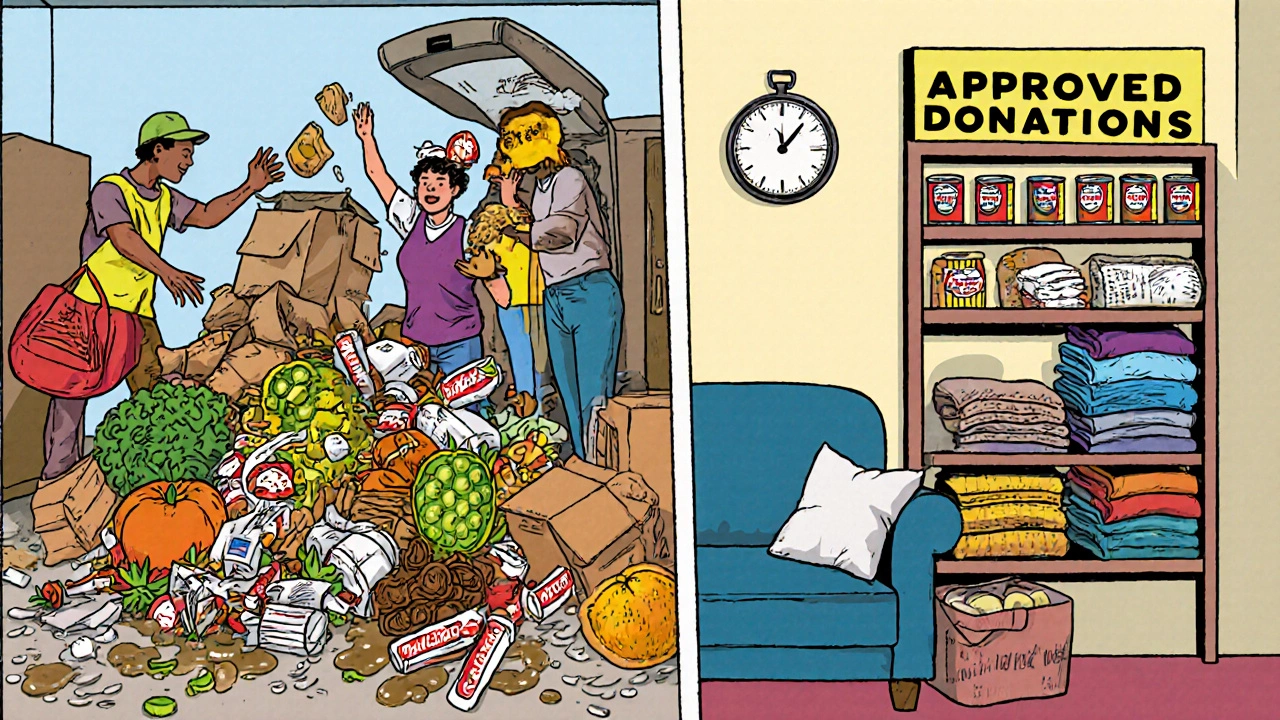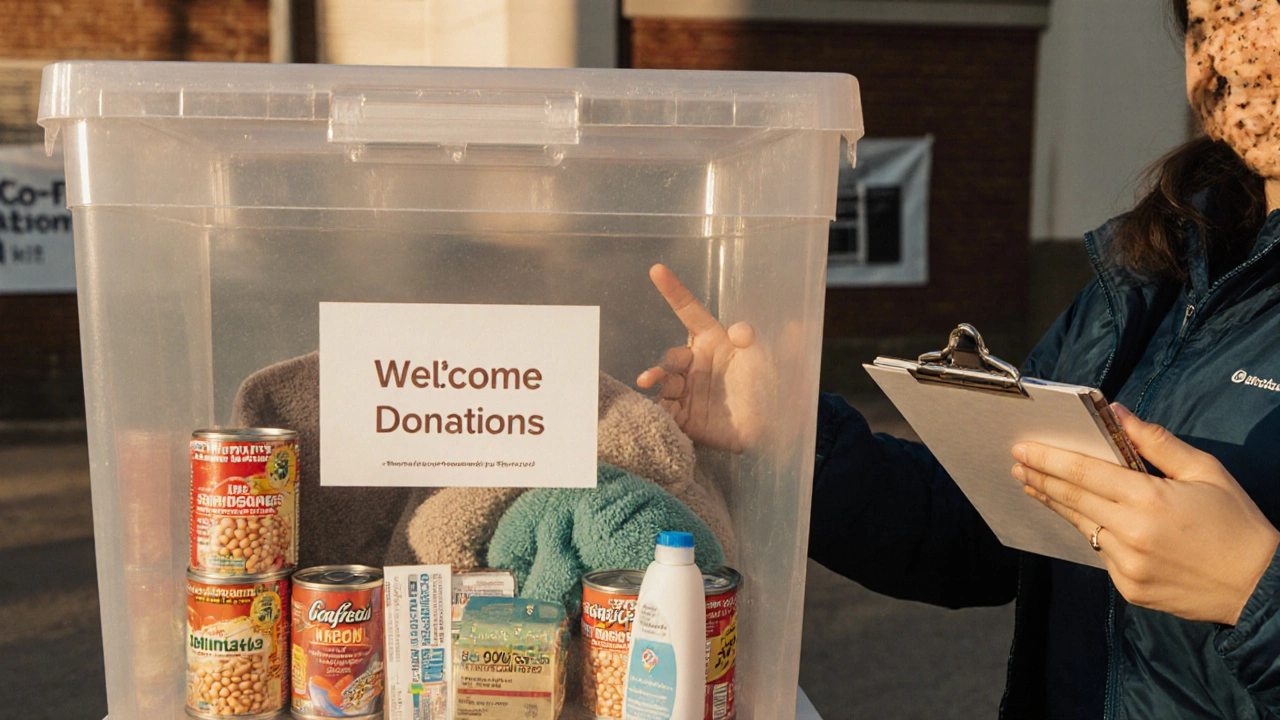Homeless Donation Checker
Check Your Donation Item
This tool helps you determine if your intended donation is appropriate for homeless individuals based on current guidelines. Select options below to see if your item is safe to give.
Select options above to see if your donation is appropriate.
Why This Matters
Many well-intentioned donations can actually create problems for homeless individuals and shelter staff. Improper items may:
- Require extra work for shelters to dispose of
- Poses health risks (e.g., foodborne illness)
- Encourage harmful habits or dependency
- Violate shelter policies and cause rejection
Donating the right items helps support dignity, health, and pathways out of homelessness. Always check with local shelters first to know their current needs.
When you see someone living on the streets, it’s natural to want to help. But not every gift does the job you think it does. Some well‑intentioned items can actually create extra work, health risks, or even put the person in danger. Knowing what not to give homeless people can make your generosity far more effective and respectful.
Key Takeaways
- Avoid giving items that are easily lost, misused, or that encourage harmful habits.
- Prioritize essentials that shelter staff can distribute safely, like fresh food, clean clothing, and hygiene kits.
- Cash can be helpful, but only when given directly to the person with clear communication about its purpose.
- Ask shelters first - they know the current needs and can guide you toward the right donations.
- Respect dignity: offer help in a friendly, non‑paternalistic way.
Why Some Well‑Meaning Gifts Backfire
Imagine you hand a warm blanket to someone on a chilly night, only to see it get soaked by rain and then left on a park bench. Or you give a box of snacks that expire in a week, turning a short‑term boost into a health hazard. The same goes for items that can be sold for cash, which may seem helpful but can also fuel a cycle of dependency or attract unwanted attention from drug dealers.
Many shelters operate on tight budgets and strict health codes. When volunteers bring in prohibited items, staff have to spend precious time sorting, cleaning, or discarding them - time that could otherwise be spent on counseling, meals, or securing housing. Understanding the impact of each donation helps keep the whole support system running smoothly.
Items That Are Generally Unsafe or Unhelpful
The following list covers the most common things people try to give that end up causing problems.
- Food that spoils quickly - like fresh fruit, dairy, or cooked meals - can attract insects and cause food‑borne illness if not refrigerated immediately. Shelters usually request non‑perishable, sealed foods.
- Clothing without proper cleaning - especially socks, underwear, or shirts with stains - can spread skin infections. Give only freshly laundered items.
- Alcohol or drug‑related paraphernalia - any beer, liquor, cigarettes, or needles not only violate shelter policies but can also trigger addiction cycles.
- Cash handed to a stranger without context - while cash is flexible, it can be misused if the person is dealing with substance abuse. If you choose cash, explain what it’s for and consider giving it directly to shelter staff.
- Pets without proper documentation - shelters often cannot accommodate animals, and abandoned pets end up on the streets.
- Large appliances or furniture - unless a shelter has specifically asked, these items are difficult to transport and store.
- Personal care items that are expired or opened - shampoo, toothpaste, or razors past their expiry can cause skin irritation.

Safe and Appreciated Alternatives
When you’re unsure what to bring, think about items that are:
- Non‑perishable and sealed.
- Clean, dry, and easy to store.
- Versatile enough to suit many people.
Here are some specific examples:
- Canned beans, tuna, or soup - high in protein, long shelf‑life, and ready to eat with a hot plate.
- Durable, season‑appropriate clothing - think fleece jackets, sturdy shoes, or winter hats that are clean and unisex.
- Personal hygiene kits - include a small soap bar, travel‑size shampoo, toothbrush, toothpaste, and a pack of wet wipes.
- Reusable water bottles - staying hydrated is crucial, and many shelters provide water stations.
- Vouchers or prepaid cards - these can be used at grocery stores or pharmacies without the stigma of cash.
- Warm blankets made of wool or fleece - portable, easy to wash, and always in demand during colder months.
- Basic medical supplies - band‑aids, antiseptic wipes, and over‑the‑counter pain relievers (e.g., ibuprofen) are useful, provided they’re sealed and in date.
How to Give Help Respectfully
Even the best‑chosen items can feel off‑putting if delivered the wrong way. Follow these simple etiquette tips:
- Ask first. Call the shelter or check its website; they often publish “wish lists.”
- Approach the person with a friendly greeting, not a lecture. “Hi, I have a warm jacket you might find useful. Would you like it?”
- Offer, don’t insist. If they decline, respect the decision.
- Maintain privacy. Hand the item discreetly rather than making a public spectacle.
- Stay safe. If you feel uncomfortable, consider donating through an organization instead of giving directly.

Quick Reference Table
| Give | Avoid | Reason |
|---|---|---|
| Sealed canned food | Fresh produce | Perishability and storage issues |
| Clean, season‑appropriate clothing | Soiled or ripped garments | Health risks and extra cleaning work |
| Personal hygiene kits | Opened or expired toiletries | Possible skin irritation |
| Warm fleece blankets | Large furniture | Transportation and space constraints |
| Prepaid grocery vouchers | Cash without context | Potential misuse in addiction scenarios |
| Basic medical supplies (sealed) | Alcohol or cigarettes | Violates shelter policies, fuels addiction |
Resources and Next Steps
Ready to turn good intentions into real impact? Here’s a short checklist:
- Visit your local shelter’s website (e.g., Wellington Homeless Service) and note their current wish list.
- Gather items from the “Safe and Appreciated Alternatives” list.
- Package items neatly - label boxes with contents and a brief note.
- Drop off during the shelter’s receiving hours or arrange a scheduled pickup.
- Consider volunteering a few hours; face‑to‑face interaction often uncovers needs you can’t anticipate.
Remember, the goal isn’t just to give away stuff; it’s to support dignity, health, and a pathway out of homelessness. When you give the right things, in the right way, you become part of that pathway.
Frequently Asked Questions
Can I give cash to a homeless person?
Cash can be useful, but it’s safest when the person is known to be stable with no active substance‑abuse issues. If you’re unsure, give cash directly to a shelter or use a prepaid card that the person can spend at a grocery store.
What kind of food is most welcome?
Non‑perishable, sealed items like canned beans, tuna, peanut butter, granola bars, and dried fruit are ideal. Avoid anything that needs refrigeration or has a short shelf life.
Are shoes a good donation?
Yes, if they’re clean, sturdy, and in good condition. Closed‑toe shoes with good tread are especially valued during winter months.
Should I offer a blanket directly on the street?
It’s better to give blankets to a shelter first. They can store them properly and hand them out when needed, ensuring the blanket reaches someone who truly needs it.
How can I find out what my local shelter needs right now?
Check the shelter’s official website, social media pages, or call their intake office. Many post up‑to‑date wish lists and specific donation days.


